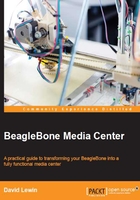
What this book covers
Chapter 1, Transforming Your BeagleBone Black into a Media Server, begins with an introduction to help you better understand why it is in your interest to have your own personal server. This chapter then describes the steps required for the installation of an improved multimedia server on steroids.
Chapter 2, Media Management, Shares, and Social Activities, gives indications to use your new server in a connected world. It begins with an explanation of the workflow that needs to be followed; there are also indications to understand what an administrator should do. The chapter ends with social sharing to let you share your contents with your friends or members of your family.
Chapter 3, Examples of Real-world Situations, deals with security because a connected server also needs to safely manage your publications. This chapter introduces you to the security role followed by two scenarios based on real-life experiences: one for a house, and another for professional activities.
Chapter 4, Getting Your Own Video and Feeds, discusses how to improve the existing server by giving you the opportunity to provide your own personal video streams. This chapter gives you the keys for hardware detection. It also presents a different topic that is still based on multimedia: configuring the server for RSS feeds.
Chapter 5, Building Your Media Player, describes the real USP of the BeagleBone Black: capes. Thus, it gives you a way to extend your board in order to create funnier and useful projects. In addition, with this exciting chapter, you will be able to build a device that can display movies and play music without making your imagination compromise because you can also extend this extension board through connectors and additional networks.
Chapter 6, Illuminate Your Imagination with Your Own Projects, lets you enter into the software part of the book using "Matrix Revolution," a fun project with funny tools: you'll use the 8 x 8 bicolor LEDs matrix from Adafruit connected to the BeagleBone Black. After a good introduction to the hardware of the board, the remaining part of this chapter is then split into three examples, starting with a simple example that allows beginners to start smoothly in Python and understand the main programming concepts related to a server and a client. This is followed by an improved version of the first example with a GUI as a laboratory for your experiments. It finally ends with a totally different example written in C++, which is a pattern generator, so you'll be able to display every disco pattern you like.
Appendix A, Troubleshooting and Tricks to Improve Your Server, covers the topics that will help you resolve issues that you might face while working with your servers, including some useful tools and troubleshooting steps.
Appendix B, Ideas to Improve Your Server, introduces some ideas to improve your server functionality.